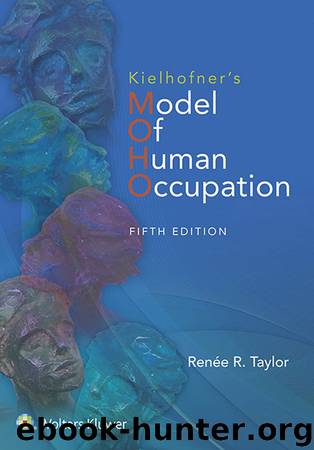Kielhofner's Model of Human Occupation: Theory and Application by Renee Taylor

Author:Renee Taylor [Taylor, Renee]
Language: eng
Format: azw3
Publisher: Wolters Kluwer Health
Published: 2017-01-31T16:00:00+00:00
FIGURE 15-1 Judith’s Strengths and Limitations Observed during the Administration of the AMPS.
THE VOLITIONAL QUESTIONNAIRE
The VQ (de las Heras, Geist, Kielhofner, & Li, 2007) is a valid and reliable observational assessment that can also be useful for monitoring volitional change over time (Alfredsson Agren & Kjellberg, 2008; Li & Kielhofner, 2004). The VQ is appropriate for any individual for whom a self-report assessment of volition is not feasible (e.g., individuals with dementia or brain damage or persons with extreme volitional problems due to environmental stresses or social traumas). The VQ is based on the recognition that, although people may have difficulty formulating goals or expressing their interests and values verbally, they routinely communicate them through actions. Thus, the VQ scale is composed of 14 items that describe behaviors reflecting values, interests, and personal causation. The items are scored using a 4-point rating scale (passive, hesitant, involved, and spontaneous). The rating indicates the extent to which the person readily exhibits volitional behaviors versus the amount of support, encouragement, and structure that is necessary to elicit them.
This assessment also recognizes that a client’s motivation may vary in different environments according to how the features of each environment match the client’s interests, values, and personal causation. Consequently, clients are observed in at least two different contexts.
Research on the VQ (Li & Kielhofner, 2004) confirmed that the items on the scale are ordered in a particular sequence from less to more volition. This sequence indicates a volitional continuum that begins with basic behaviors such as being able to initiate action and show preferences (exploratory stage of volition). Higher levels of volition are indicated by the client’s willingness to try to solve problems or correct mistakes and in the demonstration of pride (competency stage of volition). The highest level of volition is indicated by such behaviors as seeking challenges and new responsibilities (achievement stage of volition). A specific intervention protocol, the Remotivation Process, involves constant use of the VQ to guide intervention and monitor client progress (refer to Chapter 14).
Administration
Occupational therapists administer this assessment by observing and rating people while they engage in work, leisure, or daily living tasks. Because of the nature of the rating scale, the observing therapist can provide support and structure, if it is necessary, to elicit volition. Observation periods ordinarily last approximately 15 to 30 minutes. The scale and the environmental form can be completed in 20 minutes. Because the assessment can be administered as part of a therapy session in which the environment is systematically varied, it can be used efficiently to explore how different environmental factors influence volition.
The main areas to identify in the analysis of the VQ scale and qualitative information are: (1) those factors in the social and physical environment that most affect volition both positively and negatively; (2) how stable or variable volition is across environments; (3) the level of motivation a person typically displays; (4) the kinds of environmental supports that enhance the individual’s volition; and (5) the client’s personal causation, interests, and values and how they relate.
Download
This site does not store any files on its server. We only index and link to content provided by other sites. Please contact the content providers to delete copyright contents if any and email us, we'll remove relevant links or contents immediately.
Dynamic Alignment Through Imagery by Eric Franklin(4115)
Body Love by Kelly LeVeque(3012)
Barron's AP Calculus by David Bock(1775)
EMT Exam For Dummies with Online Practice by Arthur Hsieh(1651)
The Juice Lady's Remedies for Asthma and Allergies by Cherie Calbom(1604)
Fitness Walking For Dummies by Liz Neporent(1530)
Extremes: Life, Death and the Limits of the Human Body by Fong Kevin(1483)
Flight by Elephant(1481)
McGraw-Hill Nurses Drug Handbook by Patricia Schull(1465)
The Natural First Aid Handbook by Brigitte Mars(1432)
Tell by Major Margaret Witt(1380)
Skin by Unknown(1368)
Seeing Voices by Oliver Sacks(1356)
Born to Walk by James Earls(1277)
The Yoga Bible by Christina Brown(1263)
Cracking the Nursing Interview by Jim Keogh(1252)
First Aid for Colleges and Universities (10th Edition) by Mistovich Joseph J. & Limmer Daniel J. & Karren Keith J. & Hafen Brent Q(1231)
The Advantage by Lencioni Patrick M(1169)
Living Ready Pocket Manual - First Aid: Fundamentals for Survival by James Hubbard(1151)
